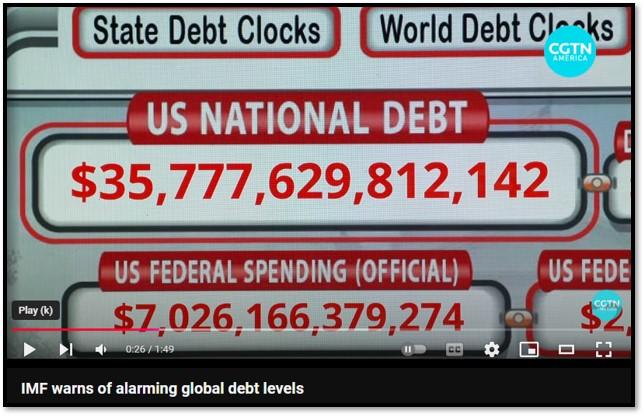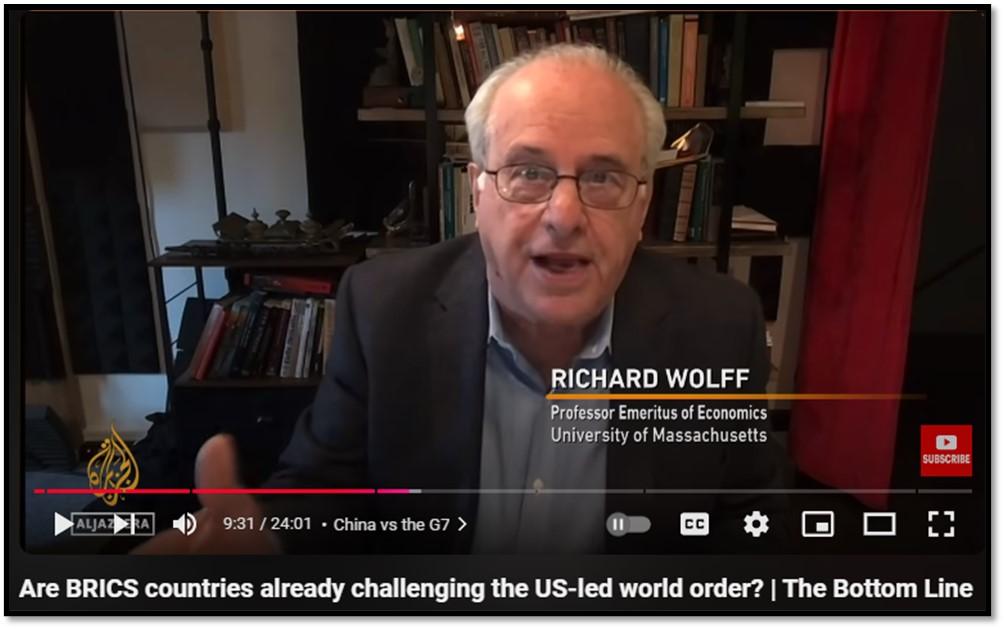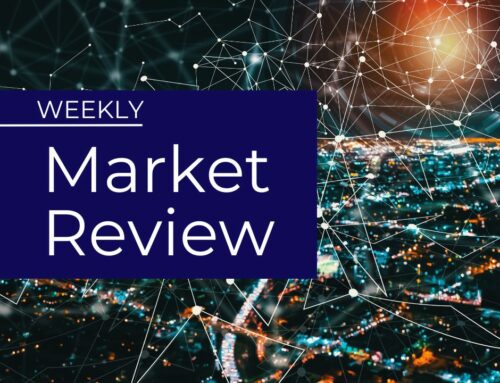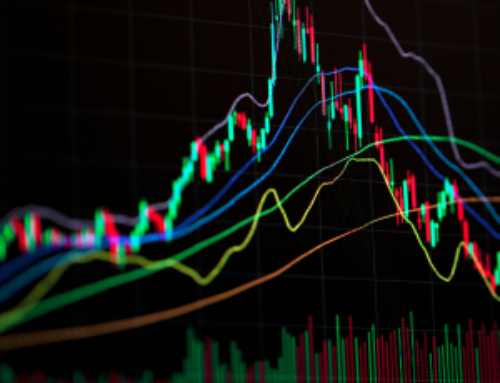

1. It is a busy week for corporate earnings with 5 of the Magnificent 7 companies to report their results.
Alphabet reported today with stronger-than-expected earnings results. The company reported blowout cloud revenue at $11.35 billion, up nearly 35% from the $8.41 billion a year ago. Alphabet’s chief financial officer says the company plans to build on existing cost-cutting efforts around using AI to streamline workflow and manage headcount and the company’s physical footprint. Could this be a trend for the rest of the other 4?
What caught my attention was IMF. The International Monetary Fund has recently raised alarms about global public debt reaching over $100 trillion by the end of 2024. This surge is largely attributed to massive government spending during the COVID-19 pandemic and continued borrowing to address economic challenges. Major economies such as the U.S. and China are at the forefront of this debt increase. The IMF has warned that, without significant fiscal adjustments, global debt levels could approach 100% of global GDP by the end of the decade. The rise in public debt poses risks to economic stability, as it limits governments’ ability to respond to future crises, including inflation, geopolitical conflicts, and climate-related disasters. High debt burdens also force governments, particularly in lower-income countries, to cut essential investments in health, education, and infrastructure. REF: WorldEconomicForum, CGTN
2. Non-U.S. equities and bonds have made a significant comeback in recent quarters due to several global economic factors.
In the third quarter of 2024, international equity markets outpaced U.S. markets, with strong performances in regions like Asia, Europe, and emerging markets. This resurgence has been driven by monetary policy changes, including interest rate cuts by global central banks such as the European Central Bank and China’s People’s Bank. For instance, China implemented various fiscal and monetary policies to stimulate domestic demand, which positively impacted its stock market.
In addition, non-U.S. bonds are also seeing a revival, largely due to the global shift towards more accommodative monetary policies. As inflation cools and interest rates peak, bond yields have started to decline, making bonds more attractive to investors. This trend is further supported by expectations of rate cuts in 2024, which are anticipated to continue driving bond prices higher. REF: DH

*With the current macro-economic backdrop, below are areas we currently favor:
- Fixed Income – Short-term Corporates (Low-Beta)
- Fixed Income – Corporates High Yield as Opportunistic Allocation, Non-US (Low-Beta)
- Businesses that contribute to and benefit from AI & Automation (Market-Risk)
- Mid Cap Stocks & Small Cap Stocks
- Clean Energy / Solar / Utilities (Market-Risk)
- Healthcare & Biotechnology (Market-Risk)
- Gold (Market-Risk)
- Industrials (Market-Risk)
- Adding Non-US Equity (Market-Risk)
3. This week, we showcase (VC) VisualCapitalist’s recent work on determining Which College Degrees Are Worth The Most.
The data was sourced from CollegeNPV and VC provided the graphics. The return on investment of a degree is the expected lifetime value of the degree (net of debt) compared to entering the workforce after high school. In today’s job market, certain college degrees stand out for offering strong financial returns and stable career paths. Degrees in computer science and software engineering are particularly valuable due to the ongoing demand for tech professionals across industries. Similarly, various branches of engineering—including electrical, mechanical, and chemical—remain highly sought after, with roles in both traditional and emerging fields. In the healthcare sector, degrees in nursing and healthcare administration lead to high-paying careers, reflecting the industry’s rapid growth. Additionally, data science and analytics are becoming increasingly critical as businesses rely on data-driven decisions. Lastly, degrees in finance and economics offer lucrative opportunities, especially in financial services. These degrees not only align with high-growth industries but also ensure long-term career prospects and competitive salaries. Now go show this to your kid(s) and let’s have constructive discussions… REF: CollegeNPV, VisualCapitalist
“Hey (William), your mother and I wanted to let you know that you can choose whatever career you heart desires, as long as it is in the top ten…”
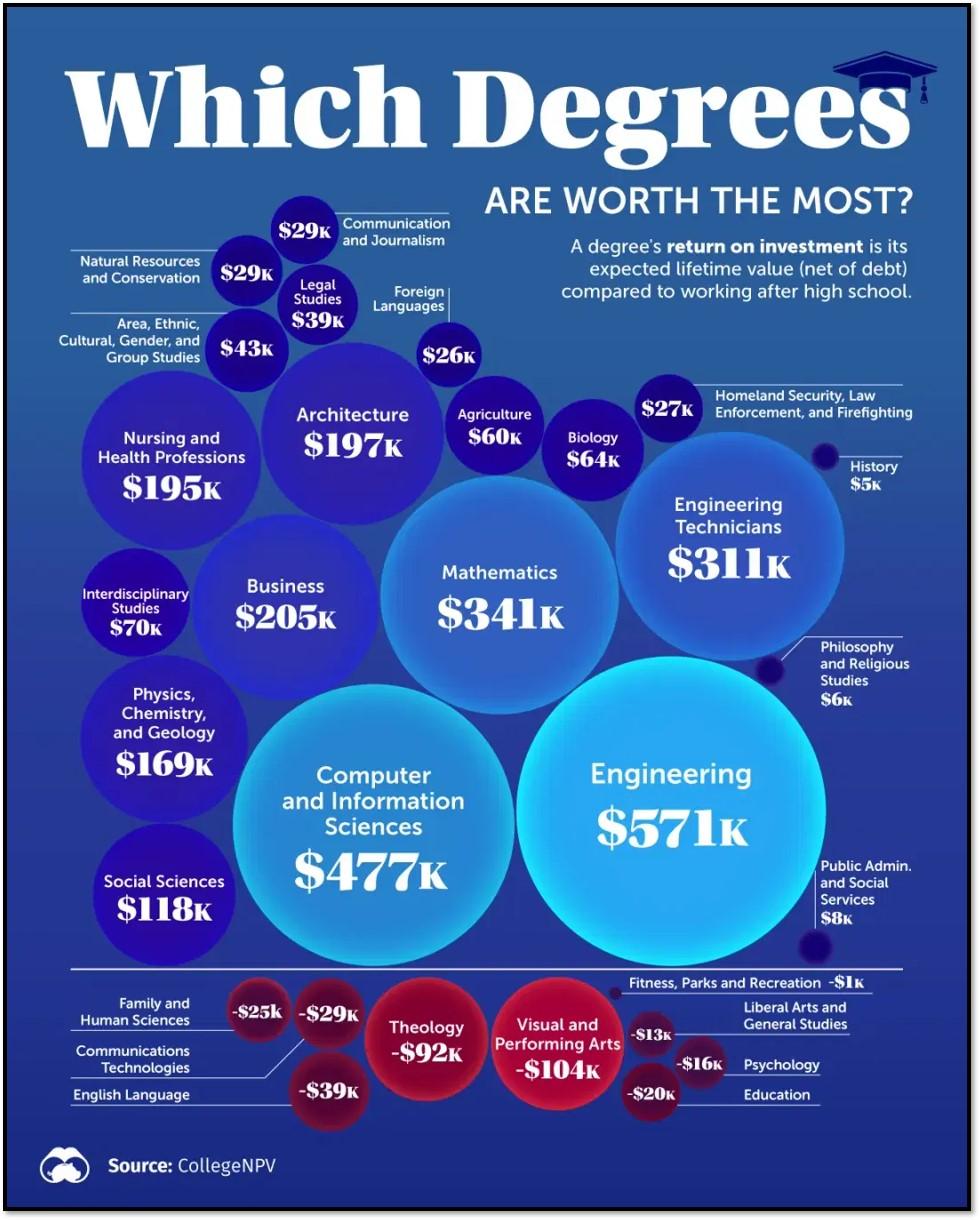
4. World Watch
4A. Puerto Rico is actively rebuilding its energy infrastructure with a focus on green energy, and Tesla is playing a key role in this transformation. Since 2017, Puerto Rico has been purchasing Tesla’s Megapacks, large-scale battery energy storage systems, to stabilize and modernize its electrical grid. These battery systems are designed to store renewable energy, such as solar power, and provide reliable backup during grid disruptions, like those caused by hurricanes. One notable project involves the installation of 430 megawatts of battery storage capacity across six strategic locations, which will help reduce energy load shifting by 90% and improve grid stability during critical situations. This effort is part of Puerto Rico’s broader goal of achieving 100% renewable energy by 2050, a commitment made under its energy public policy. The Tesla Megapacks will allow the island to rely more on renewable sources like solar and wind while reducing the need for expensive, less efficient fossil fuel-powered systems. Click onto picture below to access video. REF: SJDS, TSLA
4B. Putin hosted BRICS summit alongside Global South leaders in Kazan, Russia on October 23. At the summit, two key focuses were financial cooperation and expanding the group’s membership. The summit emphasized creating alternatives to Western-dominated financial systems, including a new payment platform to bypass SWIFT, and increasing collaboration on cross-border payments. The BRICS bloc, which now includes new members like Saudi Arabia, Iran, and Egypt, also discussed ways to support the Global South through enhanced investment platforms. The discussions further solidified BRICS’ role in challenging Western influence. The alliance that initially included Brazil, Russia, India, China and South Africa has expanded to embrace Iran, Egypt, Ethiopia, the United Arab Emirates and Saudi Arabia. Turkey, Azerbaijan and Malaysia have formally applied to become members, and several others have expressed interest in joining. Click onto picture below to access video featuring Richard Wolff, Professor Emeritus of Economics at the University of Massachusetts. REF: AlJazeera, PBS
4C. Below is an updated snapshot of the current global state of economy according to TradingEconomics as of 10/28/2024. REF: TradingEconomics
- Japan’s unemployment rate stood at 2.4% in September 2024, compared with market consensus and August’s reading of 2.5%.
- The Japanese yen traded around 153 per dollar on Tuesday, hovering close to three-month lows and remaining under pressure from policy uncertainties after Japan’s ruling coalition lost their parliamentary majority in the weekend elections.
- Singapore’s seasonally adjusted unemployment rate fell to 1.8% in Q3 of 2024 from 2.0% in the previous quarter, marking the lowest level since Q1 of 2023, a preliminary estimate showed.
- The Chinese economy grew by a seasonally adjusted 0.9% in Q3 of 2024, after a 0.7% increase in Q2. It was the ninth straight period of quarterly rise, supported by recent government initiatives aimed at stimulating consumption, mitigating deflation risks, and reversing the downturn in the real estate sector.

5. Quant & Technical Corner
Below is a selection of quantitative & technical data we monitor on a regular basis to help gauge the overall financial market conditions and the investment environment.
5A. Most recent read on the Fear & Greed Index with data as of 10/28/2024 – 7:59AM-ET is 62 (Greed). Last week’s data was 70 (Greed) (1-100). CNNMoney’s Fear & Greed index looks at 7 indicators (Stock Price Momentum, Stock Price Strength, Stock Price Breadth, Put and Call Options, Junk Bond Demand, Market Volatility, and Safe Haven Demand). Keep in mind this is a contrarian indicator! REF: Fear&Greed via CNNMoney
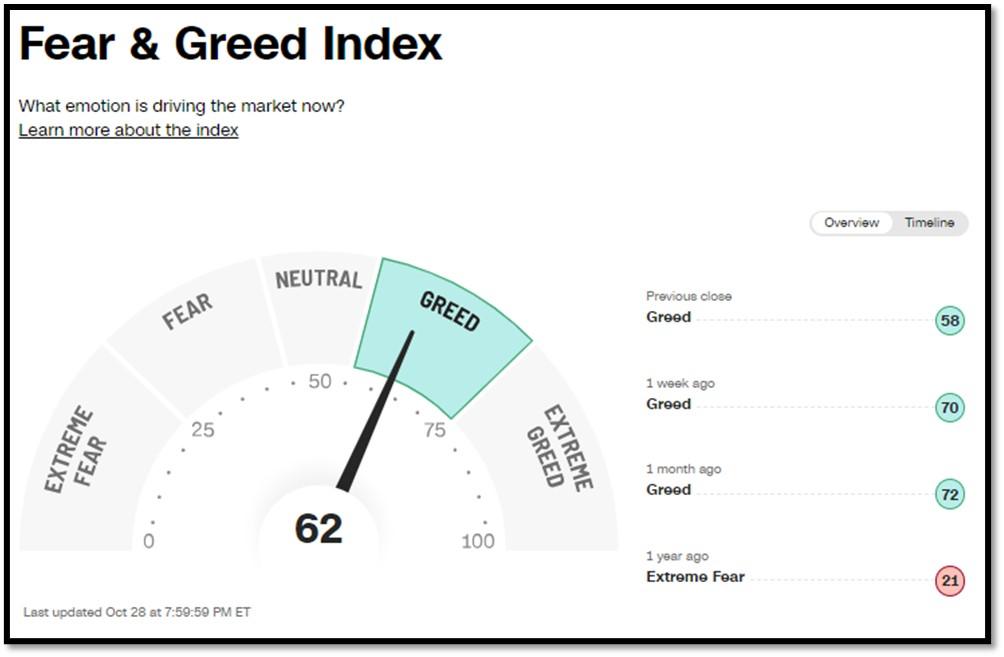
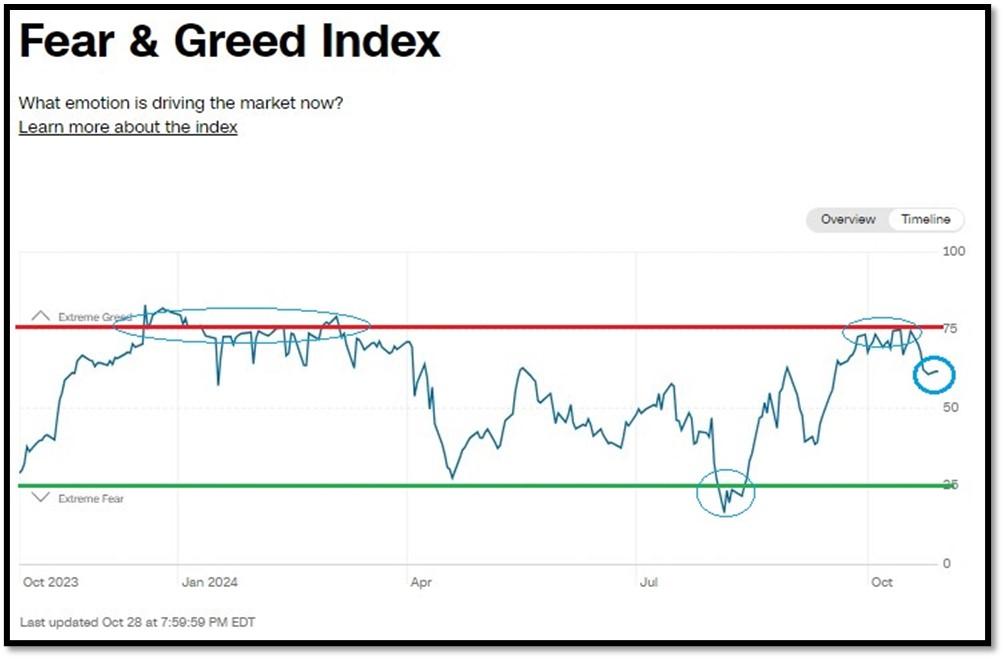
5B. St. Louis Fed Financial Stress Index’s (STLFSI4) most recent read is at –0.5358 as of October 24, 2024. A big spike up from previous readings reflecting the recent turmoil in the banking sector. Previous week’s data was -0.6079. This weekly index is not seasonally adjusted. The STLFSI4 measures the degree of financial stress in the markets and is constructed from 18 weekly data series: seven interest rate series, six yield spreads and five other indicators. Each of these variables captures some aspect of financial stress. Accordingly, as the level of financial stress in the economy changes, the data series are likely to move together. REF: St. Louis Fed
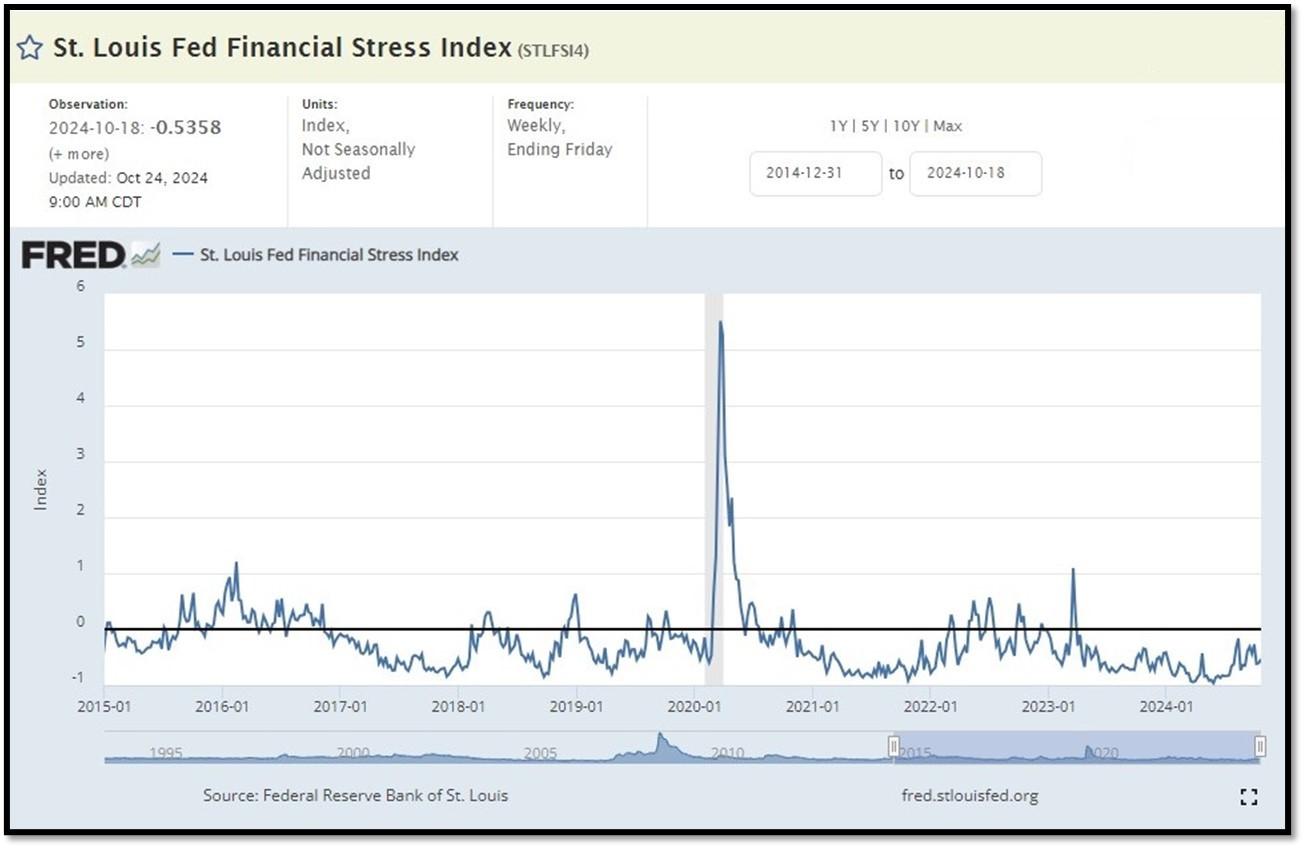
5C. University of Michigan, University of Michigan: Consumer Sentiment for September [UMCSENT] at 70.1, retrieved from FRED, Federal Reserve Bank of St. Louis, October 25, 2024. Back in June 2022, Consumer Sentiment hit a low point going back to April 1980. REF: UofM
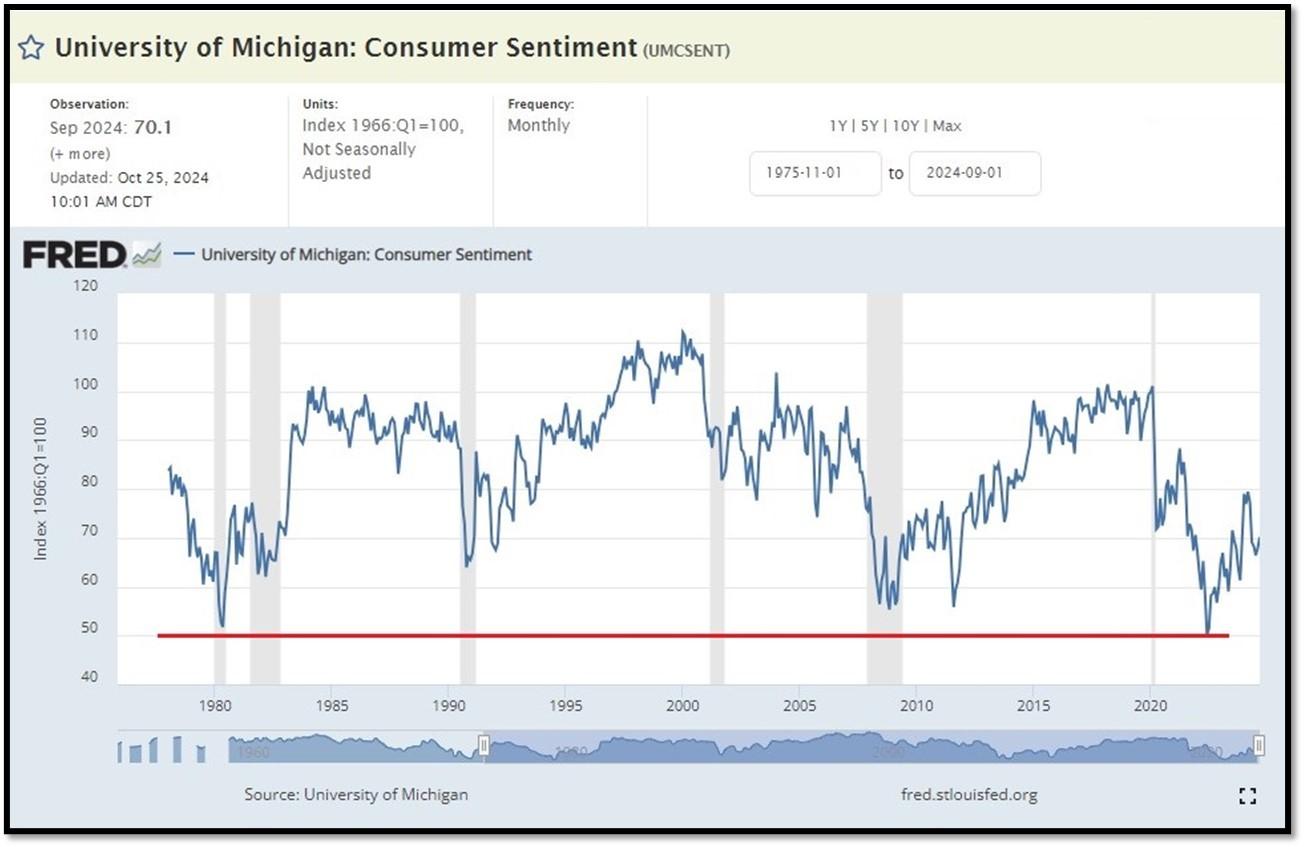
5D. The Chicago Fed National Activity Index (CFNAI) decreased to –0.28 in September from –0.01 in August. Two of the four broad categories of indicators used to construct the index decreased from August, and all four categories made negative contributions in September. The index’s three-month moving average, CFNAI-MA3, decreased to –0.19 in September from –0.14 in August. REF: ChicagoFed, September’s Report
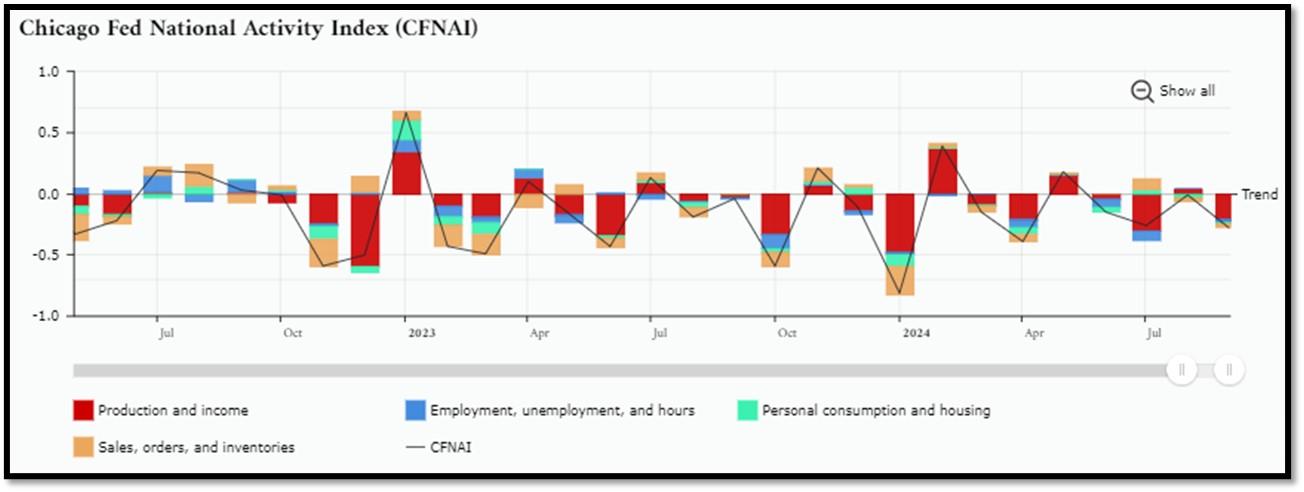
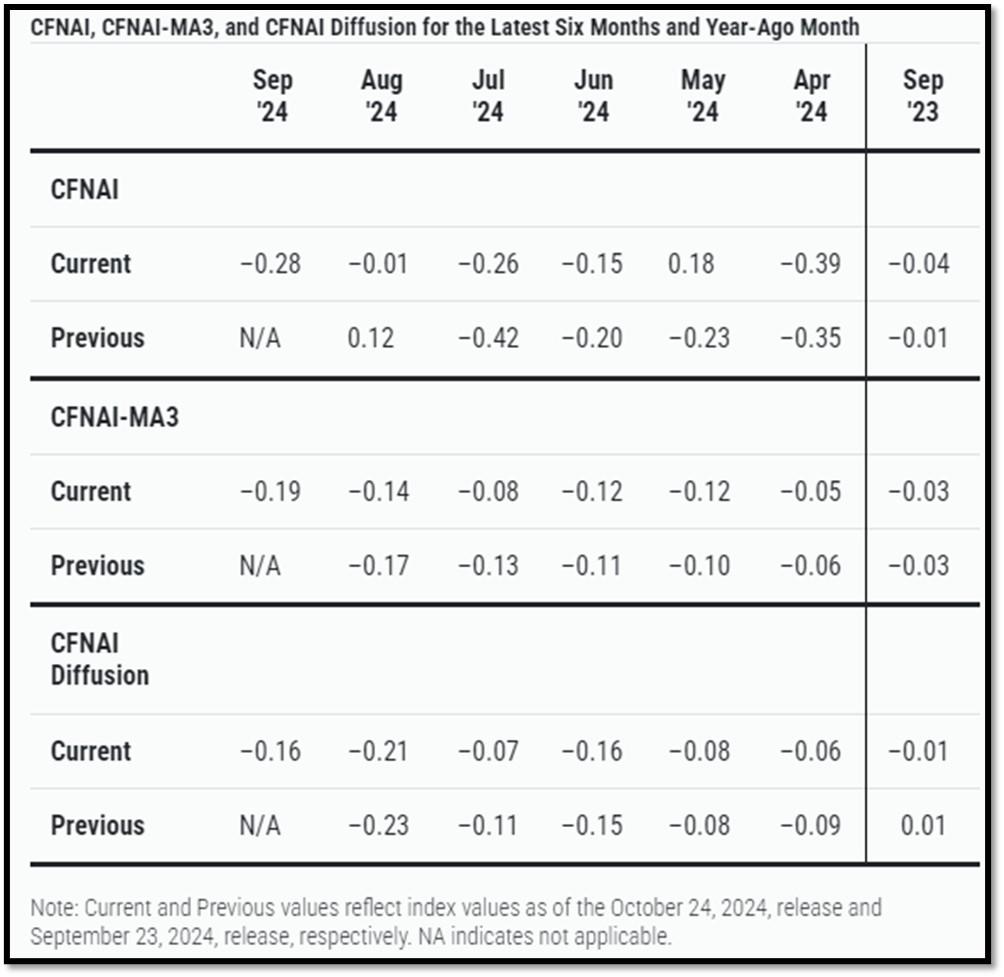
5E. (10/21/2024) The Conference Board Leading Economic Index (LEI) for the US declined by 0.5% in September 2024 to 99.7 (2016=100), following a 0.3% decline in August. Over the six-month period between March and September 2024, the LEI fell by 2.6%, more than its 2.2% decline over the previous six-month period (September 2023 to March 2024). The composite economic indexes are the key elements in an analytic system designed to signal peaks and troughs in the business cycle. The indexes are constructed to summarize and reveal common turning points in the economy in a clearer and more convincing manner than any individual component. The CEI is highly correlated with real GDP. The LEI is a predictive variable that anticipates (or “leads”) turning points in the business cycle by around 7 months. Shaded areas denote recession periods or economic contractions. The dates above the shaded areas show the chronology of peaks and troughs in the business cycle. The ten components of The Conference Board Leading Economic Index® for the U.S. include: Average weekly hours in manufacturing; Average weekly initial claims for unemployment insurance; Manufacturers’ new orders for consumer goods and materials; ISM® Index of New Orders; Manufacturers’ new orders for nondefense capital goods excluding aircraft orders; Building permits for new private housing units; S&P 500® Index of Stock Prices; Leading Credit Index™; Interest rate spread (10-year Treasury bonds less federal funds rate); Average consumer expectations for business conditions. REF: ConferenceBoard, LEI Report for September (Released on 10/21/2024)

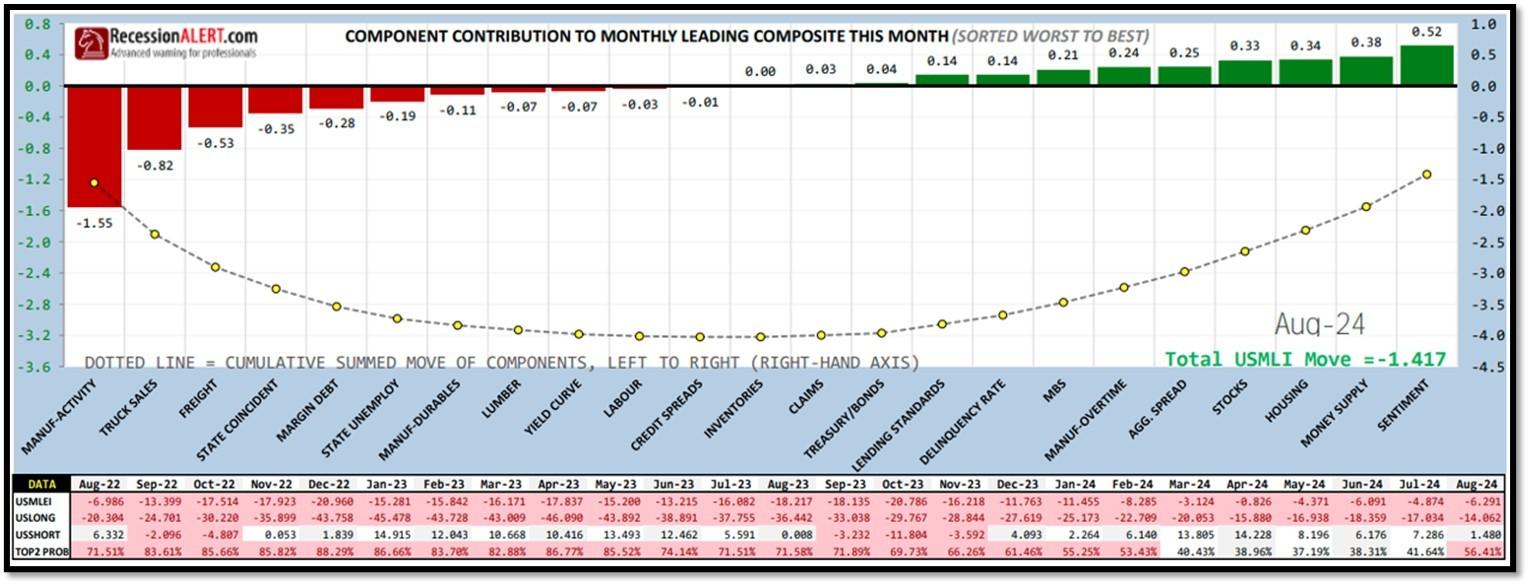
5F. Probability of U.S. falling into Recession within 3 to 4 months is currently at 66.48% (with data as of 10/21/2024 – Next Report 11/4/2024) according to RecessionAlert Research. Last release’s data was at 71.04%. This report is updated every two weeks. REF: RecessionAlertResearch
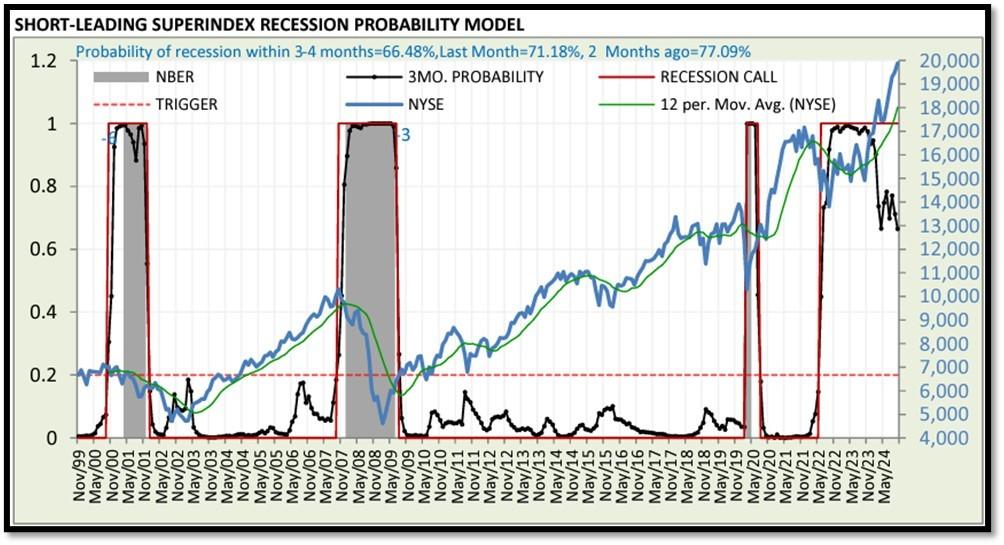
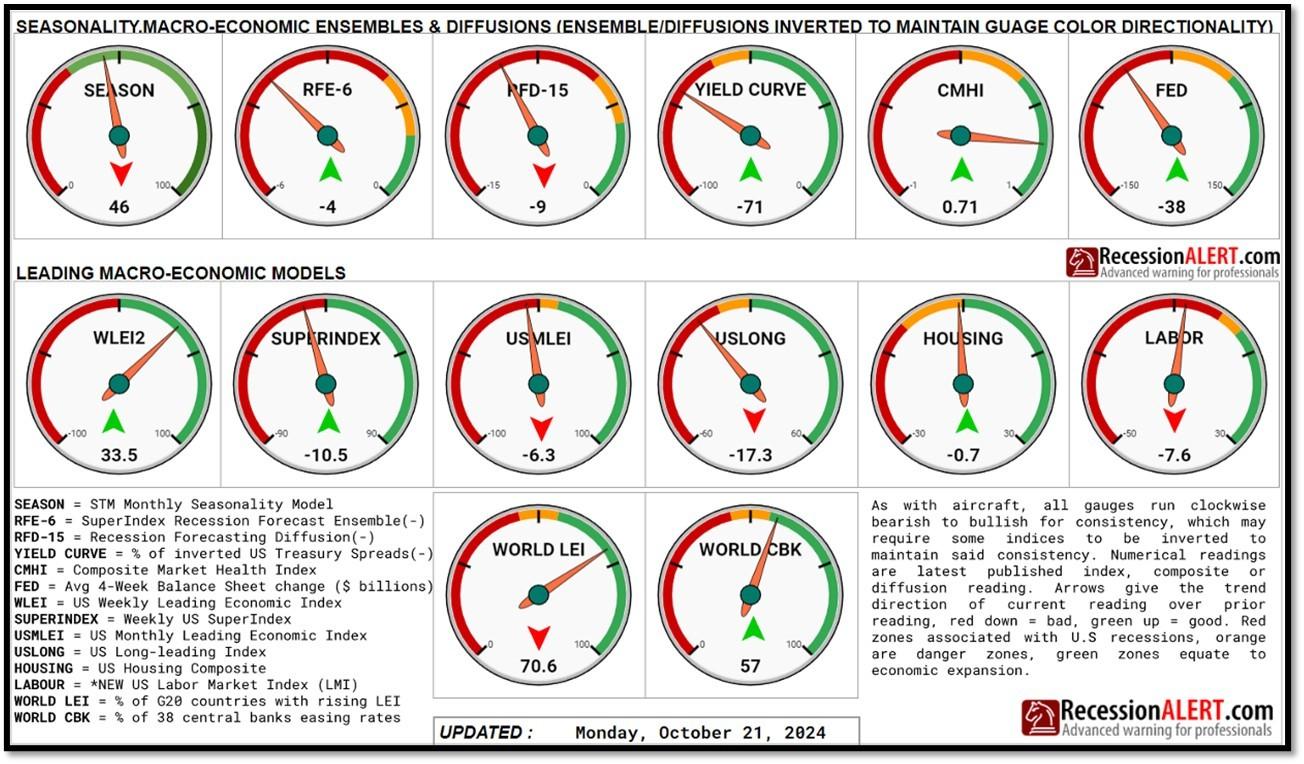
5G. Yield Curve as of 10/28/2024 is showing Dis-inversion to Flattening. Spread on the 10-yr Treasury Yield (4.27%) minus yield on the 2-yr Treasury Yield (4.13%) is currently at 14 bps. REF: Stockcharts The yield curve—specifically, the spread between the interest rates on the ten-year Treasury note and the three-month Treasury bill—is a valuable forecasting tool. It is simple to use and significantly outperforms other financial and macroeconomic indicators in predicting recessions two to six quarters ahead. REF: NYFED
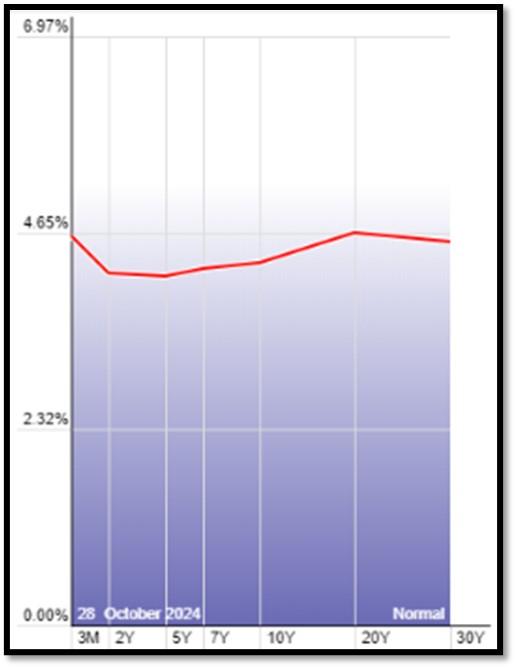
5H. Recent Yields in 10-Year Government Bonds. REF: Source is from Bloomberg.com, dated 10/28/2024, rates shown below are as of 10/28/2024, subject to change.
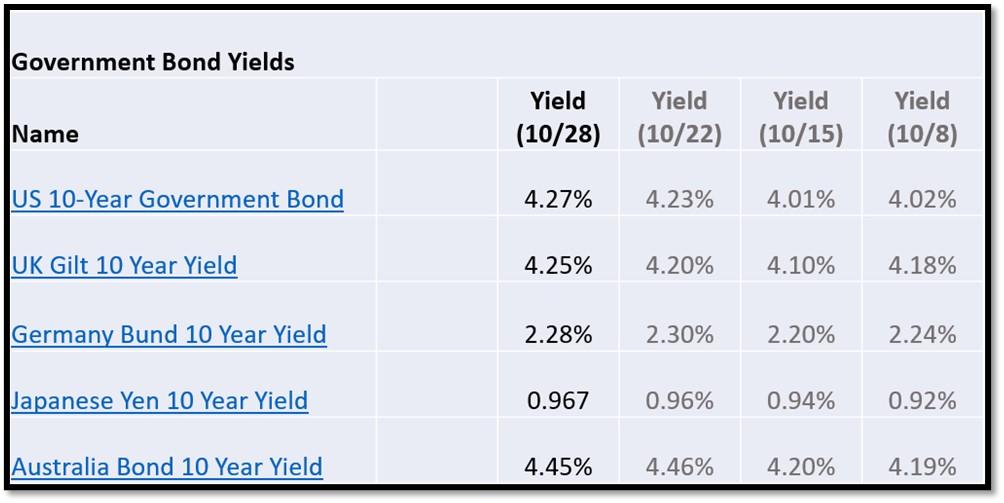
The 10-Year US Treasury Yield… REF: StockCharts1, StockCharts2
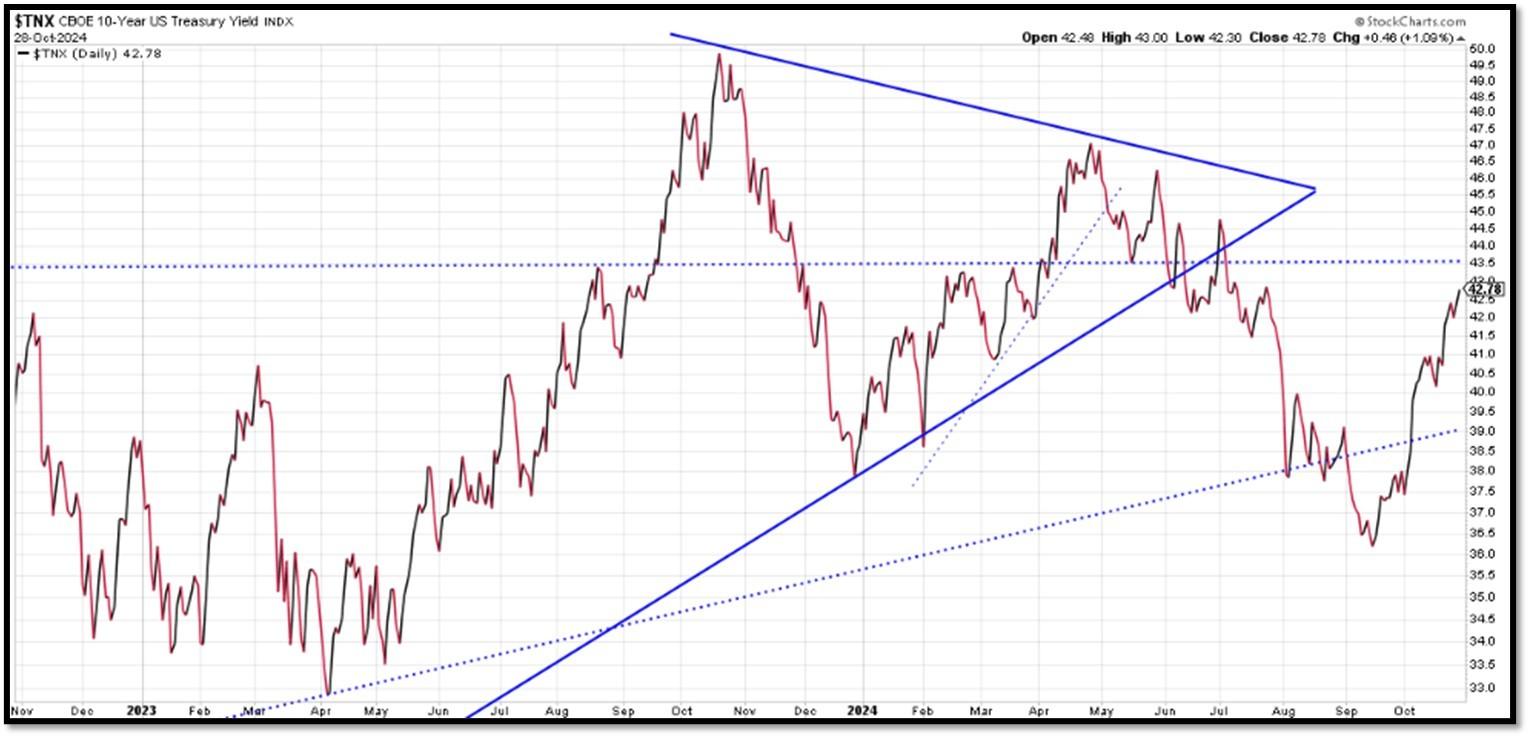
The 10-year yield – Spiked towards top of trend…
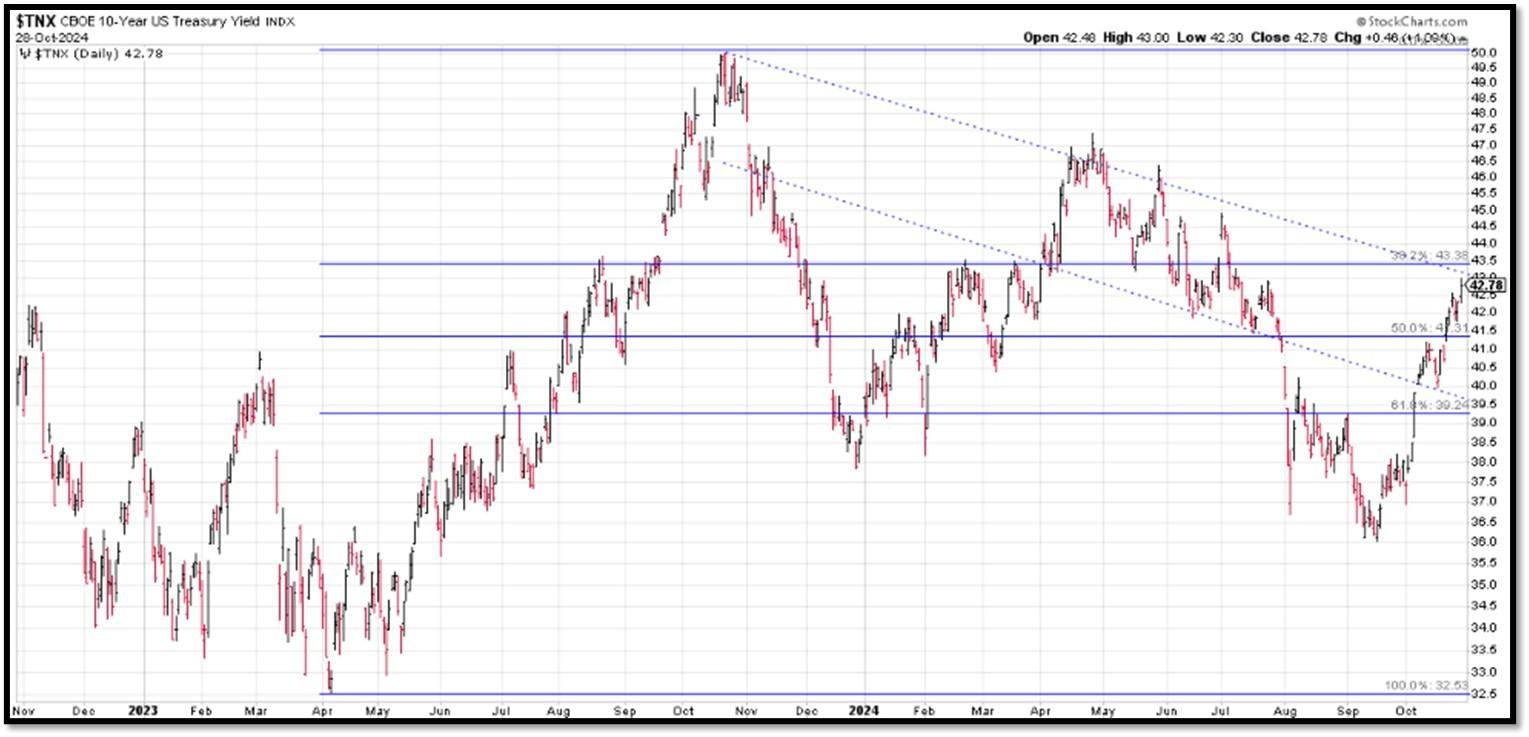
10-Year Real Interest Rate at 1.5016% as of 10/10/24. REF: REAINTRATREARAT10Y

Federal government Interest Payments increased $22B to $1.096 T as of Q2-2024. REF: FRED-A091RC1Q027SBEA

Interest payments as a percentage of GDP increased from 1.84853 in 2022 to 2.37794 as of 10/18/24. REF: FRED-FYOIGDA188S

5I. (10/28/2024) Today’s National Average 30-Year Fixed Mortgage Rate is 7.00% (All Time High was 8.03% on 10/19/23). Last week’s data was 6.85%. This rate is the average 30-year fixed mortgage rates from several different surveys including Mortgage News Daily (daily index), Freddie Mac (weekly survey), Mortgage Bankers Association (weekly survey) and FHFA (monthly survey). REF: MortgageNewsDaily, Today’s Average Rate
The recent spike in the 30-year fixed-rate jumbo mortgage to 7%, compared to Freddie Mac’s rate at 6.54% and the Mortgage Bankers Association (MBA) rate at 6.52%, highlights key differences in the mortgage market. Jumbo mortgages, which exceed the conforming loan limits set by government agencies like Freddie Mac, typically carry higher interest rates because they are riskier for lenders. These loans are not backed by government entities, which increases the risk for lenders and, consequently, leads to higher rates. In contrast, Freddie Mac and MBA provide averages for conforming loans, which meet federal guidelines and have lower risk due to government backing, keeping their rates lower.
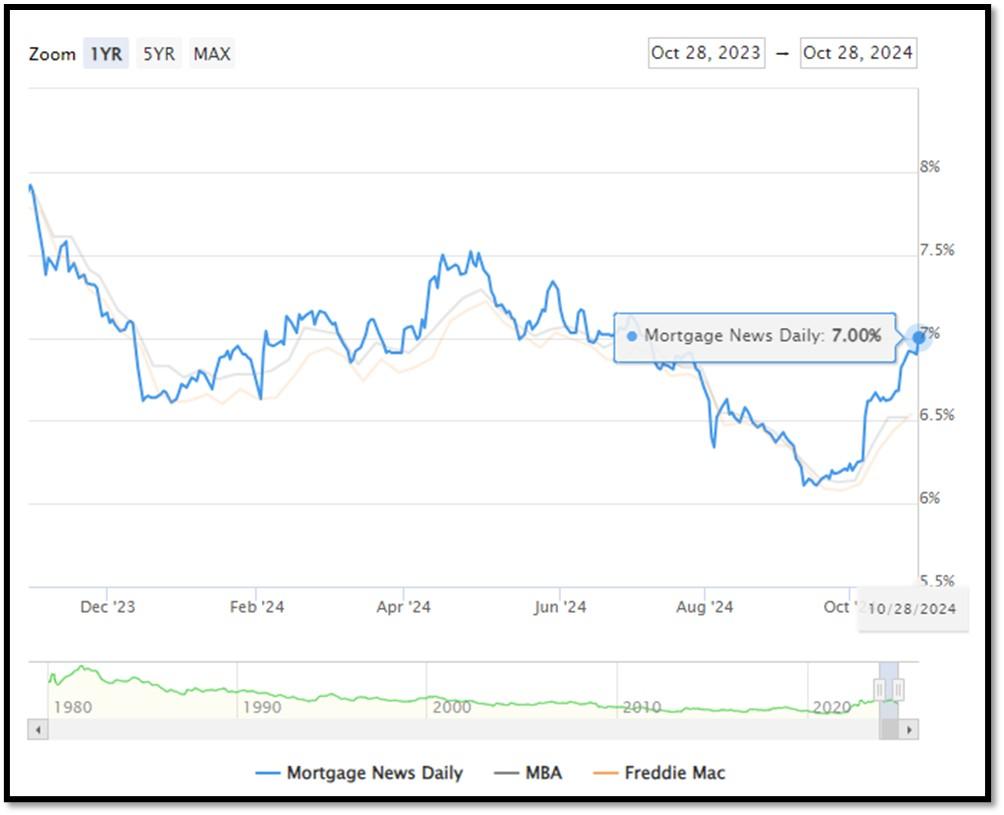
(10/15/24) Housing Affordability Index for Aug = 98.6 // July = 95 // June = 93.3 // May = 93.1 // April = 95.9 // March = 101.1 // February = 103.0. Data provided by Yardeni Research. REF: Yardeni
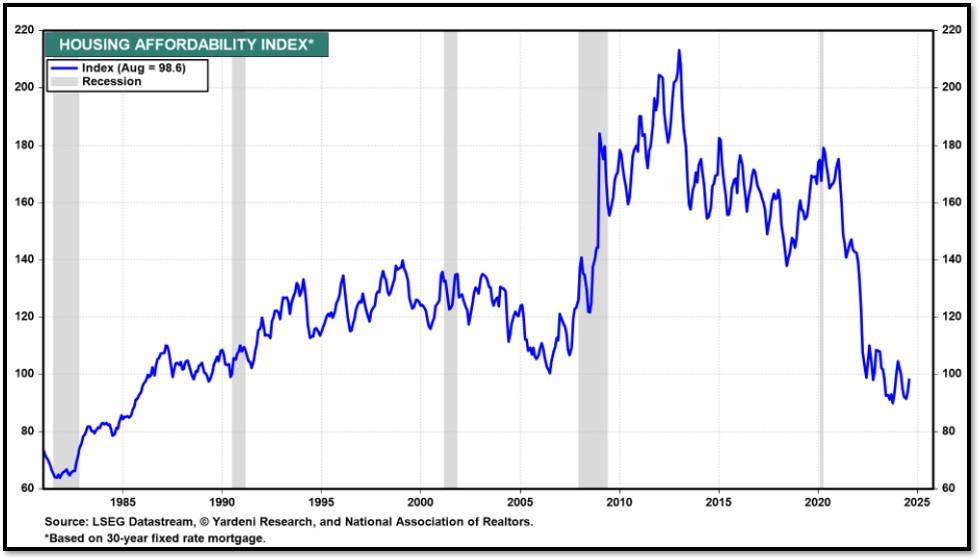
5J. Velocity of M2 Money Stock (M2V) with current read at 1.385 as of (Q2-2024 updated 9/26/2024). Previous quarter’s data was 1.368. The velocity of money is the frequency at which one unit of currency is used to purchase domestically- produced goods and services within a given time period. In other words, it is the number of times one dollar is spent to buy goods and services per unit of time. If the velocity of money is increasing, then more transactions are occurring between individuals in an economy. Current Money Stock (M2) report can be viewed in the reference link. REF: St.LouisFed-M2V
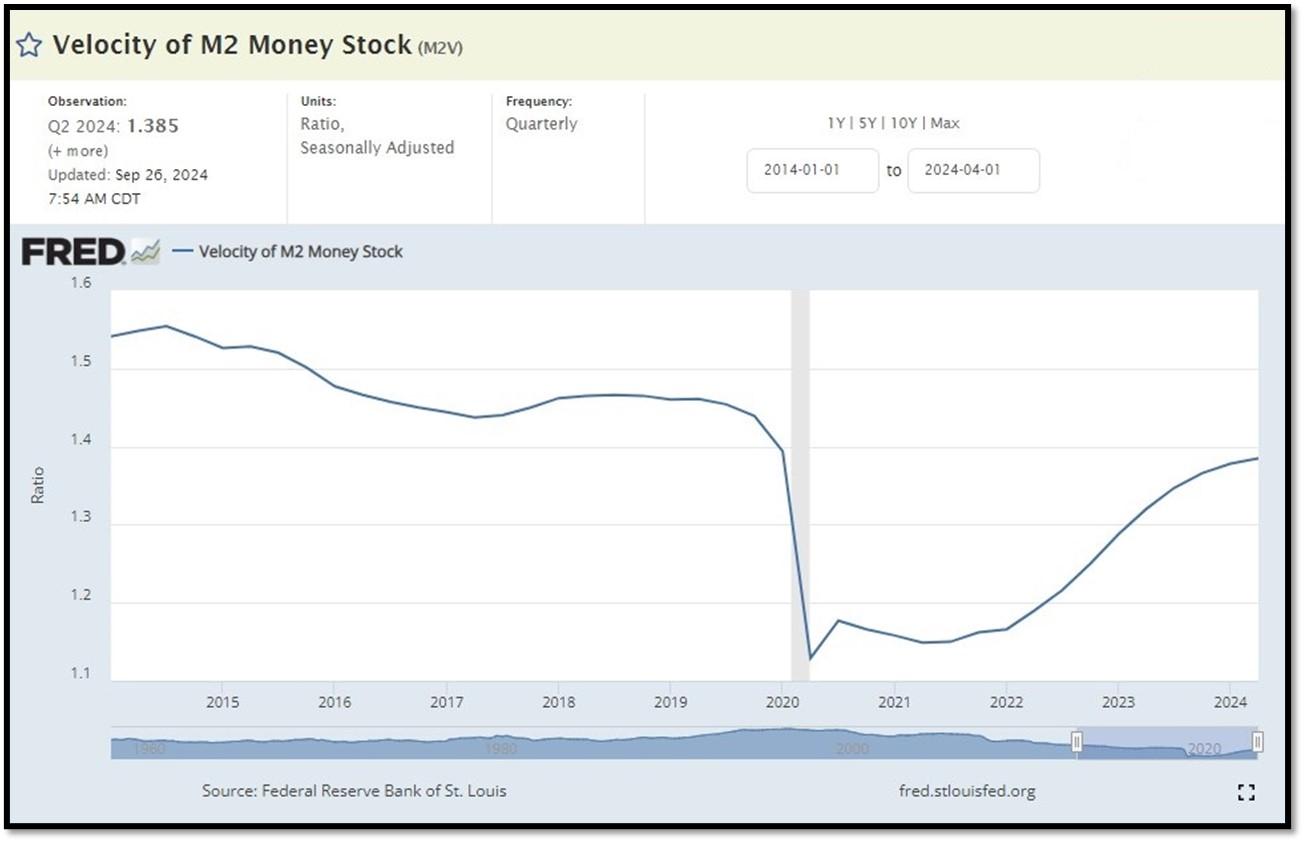
M2 consists of M1 plus (1) small-denomination time deposits (time deposits in amounts of less than $100,000) less IRA and Keogh balances at depository institutions; and (2) balances in retail MMFs less IRA and Keogh balances at MMFs. Seasonally adjusted M2 is constructed by summing savings deposits (before May 2020), small-denomination time deposits, and retail MMFs, each seasonally adjusted separately, and adding this result to seasonally adjusted M1. Board of Governors of the Federal Reserve System (US), M2 [M2SL], retrieved from FRED, Federal Reserve Bank of St. Louis; Updated on October 22, 2024. REF: St.LouisFed-M2
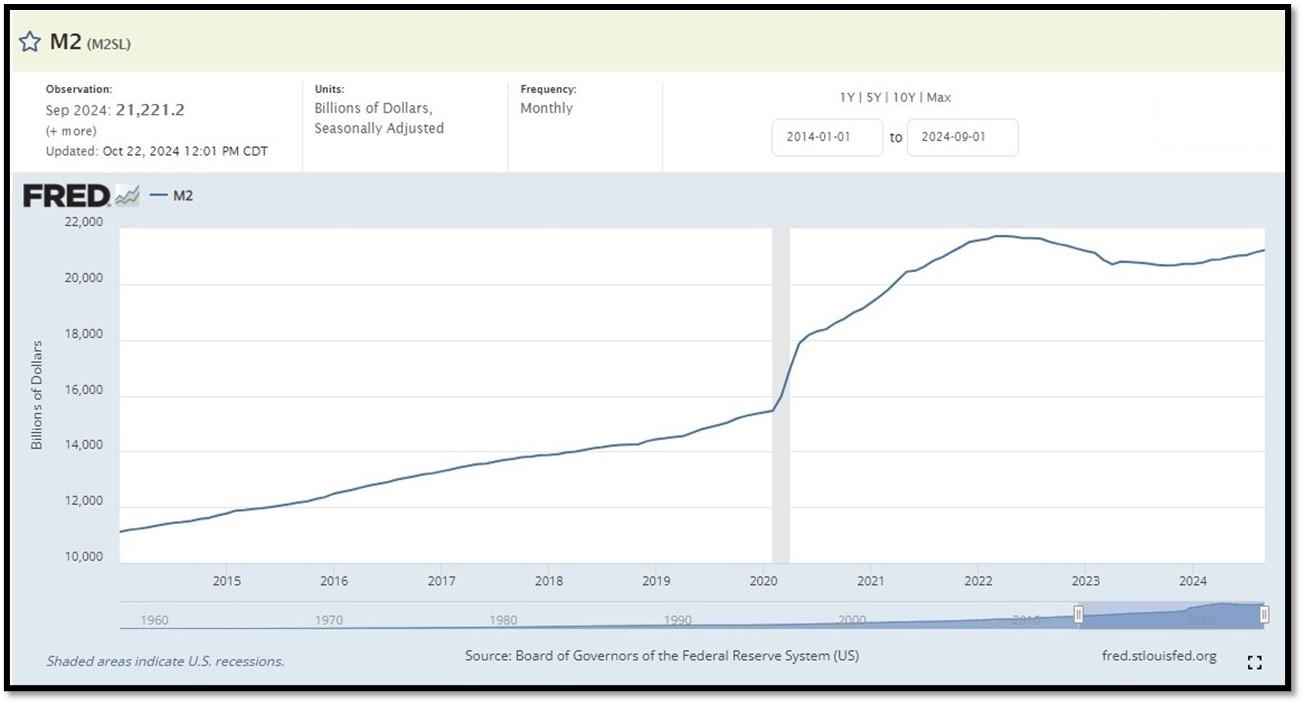
Money Supply M0 in the United States decreased to 5,588,400 USD Million in September from 5,670,200 USD Million in August of 2024. Money Supply M0 in the United States averaged 1,149,440.43 USD Million from 1959 until 2024, reaching an all-time high of 6,413,100.00 USD Million in December of 2021 and a record low of 48,400.00 USD Million in February of 1961. REF: TradingEconomics, M0
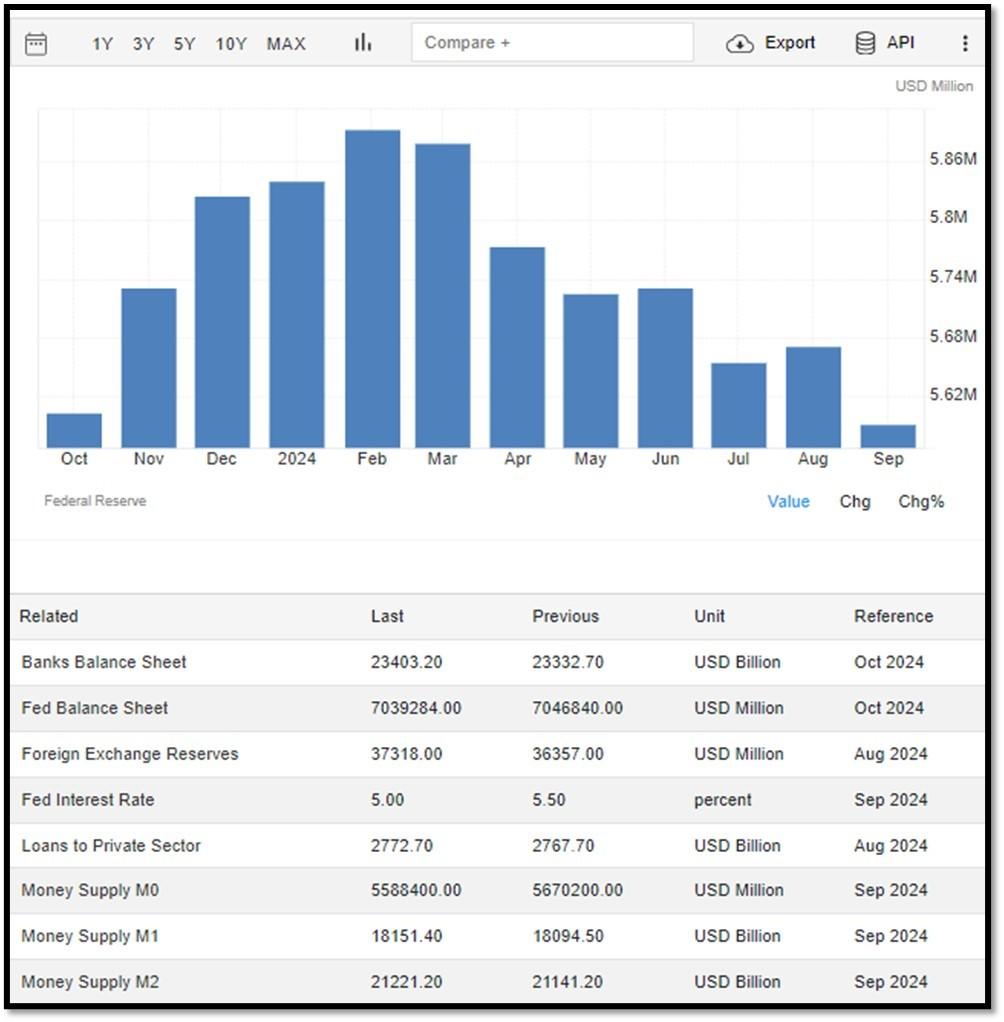
5K. In September, the Consumer Price Index for All Urban Consumers rose 0.2 percent, seasonally adjusted, and rose 2.4 percent over the last 12 months, not seasonally adjusted. The index for all items less food and energy increased 0.3 percent in September (SA); up 3.3 percent over the year (NSA). October 2024 CPI data are scheduled to be released on November 13, 2024, at 8:30AM-ET. REF: BLS, BLS.GOV

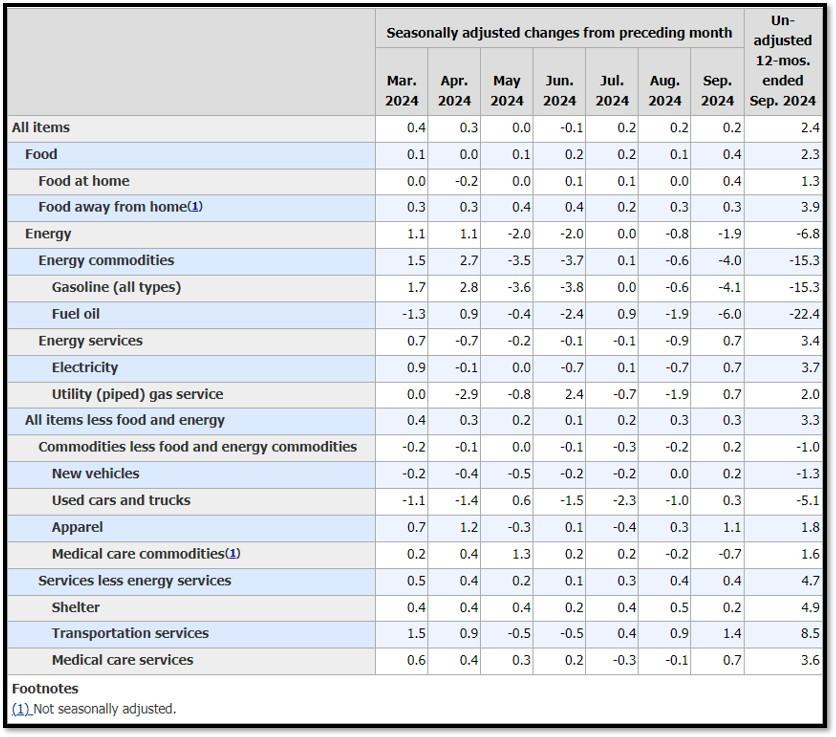
5L. Technical Analysis of the S&P500 Index. Click onto reference links below for images.
- Short-term Chart: Less Bullish on 10/28/2024 – REF: Short-term S&P500 Chart by Marc Slavin (Click Here to Access Chart)
- Medium-term Chart: Bullish on 10/28/2024 – REF: Medium-term S&P500 Chart by Marc Slavin (Click Here to Access Chart)
- Market Timing Indicators – S&P500 Index as of 10/28/2024 – REF: S&P500 Charts (7 of them) by Joanne Klein’s Top 7 (Click Here to Access Updated Charts)
- A well-defined uptrend channel shown in green with S&P500 getting back on trend. REF: Stockcharts
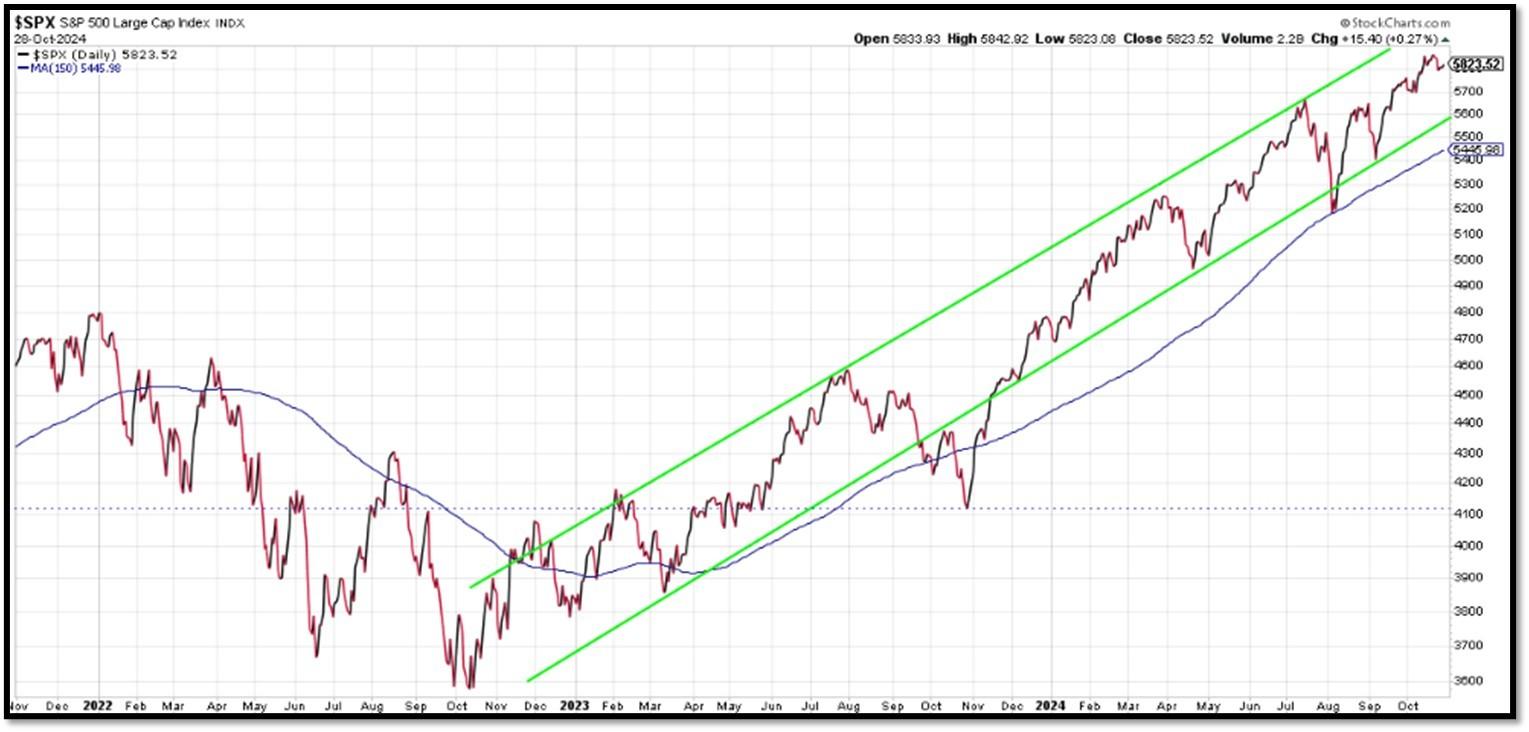
- S&P500 and CBOE Volatility Index (VIX) as of 10/25/2024. REF: FRED, Today’s Print
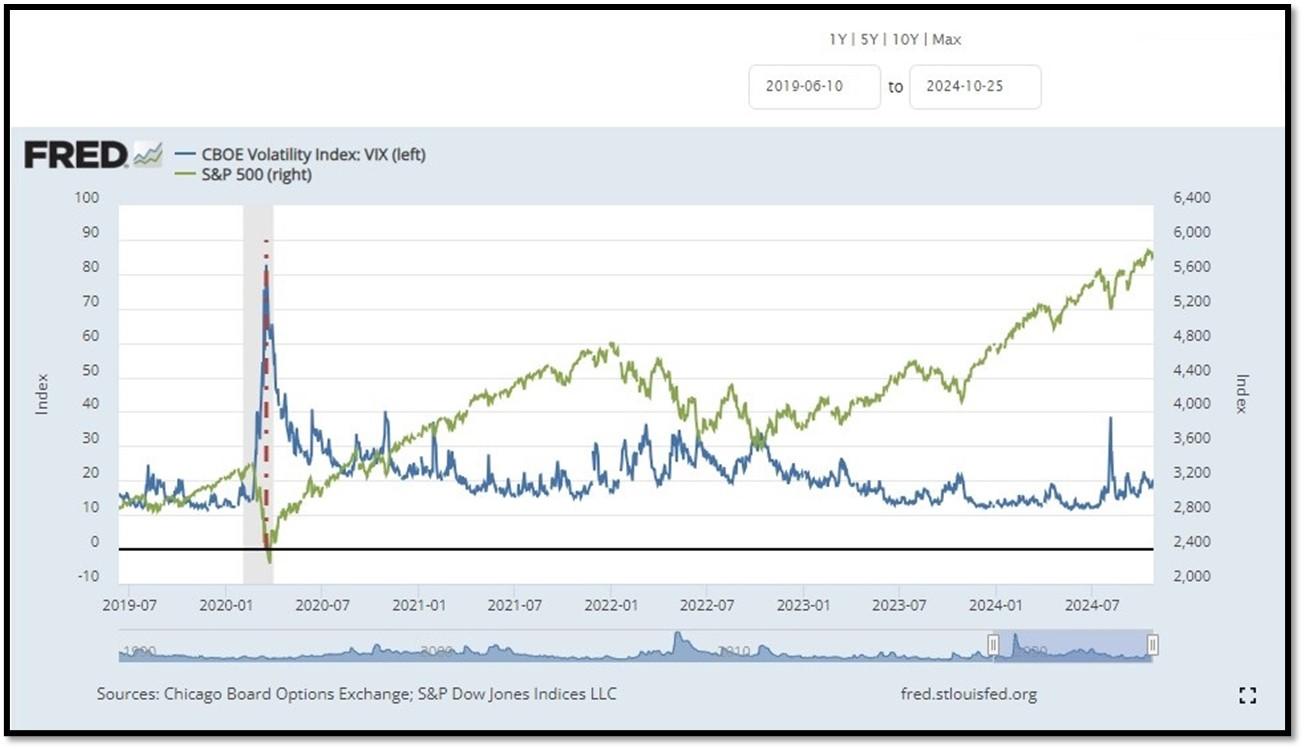
5M. Most recent read on the Crypto Fear & Greed Index with data as of 10/29/2024au is 72 (Greed). Last week’s data was 70 (Greed) (1-100). Fear & Greed Index – A Contrarian Data. The crypto market behavior is very emotional. People tend to get greedy when the market is rising which results in FOMO (Fear of missing out). Also, people often sell their coins in irrational reaction of seeing red numbers. With the Crypto Fear and Greed Index, the data try to help save investors from their own emotional overreactions. There are two simple assumptions:
- Extreme fear can be a sign that investors are too worried. That could be a buying opportunity.
- When Investors are getting too greedy, that means the market is due for a correction.
Therefore, the program for this index analyzes the current sentiment of the Bitcoin market and crunch the numbers into a simple meter from 0 to 100. Zero means “Extreme Fear”, while 100 means “Extreme Greed”. REF: Alternative.me, Today’sReading

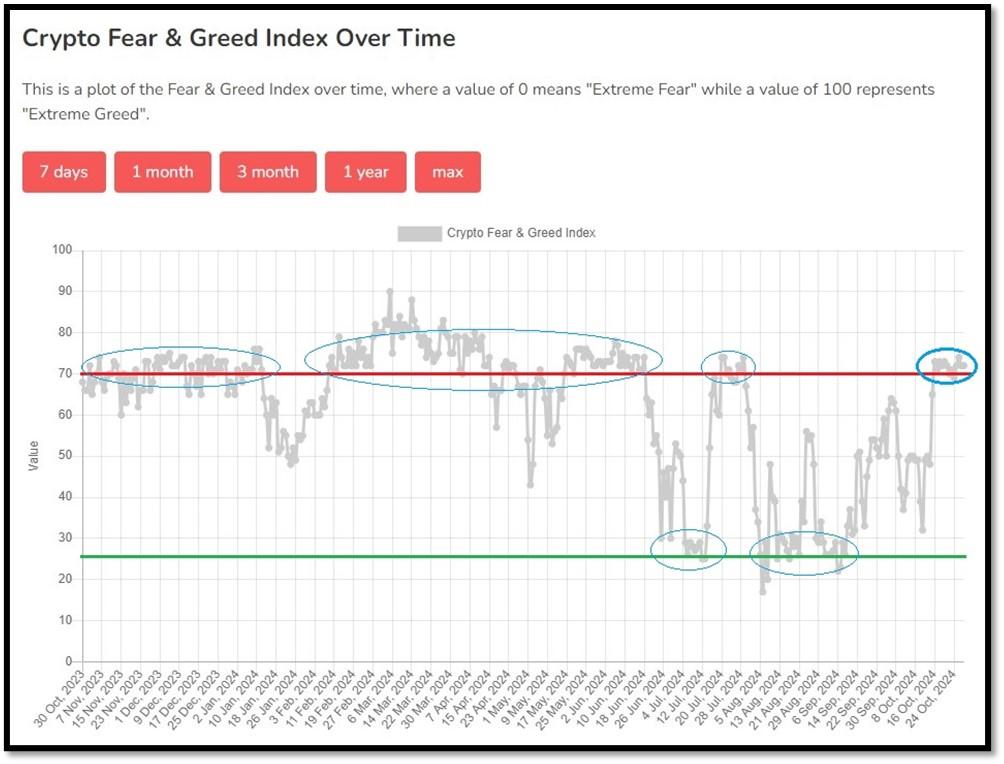
Bitcoin – Could it break out to the upside? REF: Stockcharts


Len writes much of his own content, and also shares helpful content from other trusted providers like Turner Financial Group (TFG).
The material contained herein is intended as a general market commentary, solely for informational purposes and is not intended to make an offer or solicitation for the sale or purchase of any securities. Such views are subject to change at any time without notice due to changes in market or economic conditions and may not necessarily come to pass. This information is not intended as a specific offer of investment services by Dedicated Financial and Turner Financial Group, Inc.
Dedicated Financial and Turner Financial Group, Inc., do not provide tax, legal or accounting advice. You should consult your own tax, legal and accounting advisors before engaging in any transaction.
Any hyperlinks in this document that connect to Web Sites maintained by third parties are provided for convenience only. Turner Financial Group, Inc. has not verified the accuracy of any information contained within the links and the provision of such links does not constitute a recommendation or endorsement of the company or the content by Dedicated Financial or Turner Financial Group, Inc. The prices/quotes/statistics referenced herein have been obtained from sources verified to be reliable for their accuracy or completeness and may be subject to change.
Past performance is no guarantee of future returns. Investing involves risk and possible loss of principal capital. The views and strategies described herein may not be suitable for all investors. To the extent referenced herein, real estate, hedge funds, and other private investments can present significant risks, including loss of the original amount invested. All indexes are unmanaged, and an individual cannot invest directly in an index. Index returns do not include fees or expenses.
Turner Financial Group, Inc. is an Investment Adviser registered with the United States Securities and Exchange Commission however, such registration does not imply a certain level of skill or training and no inference to the contrary should be made. Additional information about Turner Financial Group, Inc. is also available at www.adviserinfo.sec.gov. Advisory services are only offered to clients or prospective clients where Turner Financial Group, Inc. and its representatives are properly licensed or exempt from licensure. No advice may be rendered by Turner Financial Group, Inc. unless a client service agreement is in place.


